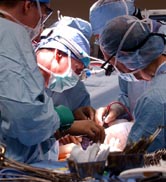Formerly conjoined babies begin recovery after separation surgery
For the parents of conjoined twins Abbigail and Isabelle Carlsen, placing their baby daughters on an operating table was one of the hardest moments.

But the daylong surgery worked. Doctors untangled their livers, repositioned their hearts and divided a shared intestine. The girls, who spent their first five months with their noses just inches apart, finally slept in separate beds Friday.
"We've had our prayers answered up to now," the girls' parents, Amy and Jesse Carlsen, wrote in a message posted Saturday on the family's Web journal. "And we will continue to pray for a perfect recovery."
The girls, separated by a team of Mayo Clinic surgeons, have a tough recovery ahead. On Saturday, they remained in intensive care under sedation, breathing with the assistance of ventilators, the Mayo Clinic said in a statement.
When the girls were born Nov. 29 to the North Dakota couple, they were joined at the diaphragm, pancreas and liver, and shared a common bile duct and part of an intestine.
A 70-member Mayo Clinic team has cared for the twins since Feb. 24. About 30 people took part in the operation, with specialists rotating in and out of the operating room. The separation, which took nearly seven hours, was like one major surgery after another.
After the procedure began, doctors confirmed the girls had two separate hearts. Medical imaging done in the weeks before the surgery showed Isabelle's heart was tipped into her sister's body and would have to be moved.
Mayo spokesman Lee Aase said Isabelle's blood pressure remained stable as her heart was maneuvered into her own chest cavity.
Doctors also removed both of the girls' gall bladders during the procedure, so the drainage systems in the organs could be rerouted, Aase said.
He said that after the girls' livers were separated, the medical team applauded, having completed one of the more complicated parts of the operation because of the way the organs were fused and because the circulatory structures inside the livers needed to be divided correctly.
Isabelle retained the common bile duct, and doctors constructed a biliary structure for Abbigail. The length of their intestines was a concern, too, but doctors found enough and divided it evenly between the girls.
Doctors had estimated there was a 90 percent to 95 percent chance that both girls would survive.
"The girls did great," said Dr. Randall Flick, the lead anesthesiologist. "The credit goes to them. I think they are tough little girls," reports AP.
O.Ch.
Subscribe to Pravda.Ru Telegram channel, Facebook, RSS!




